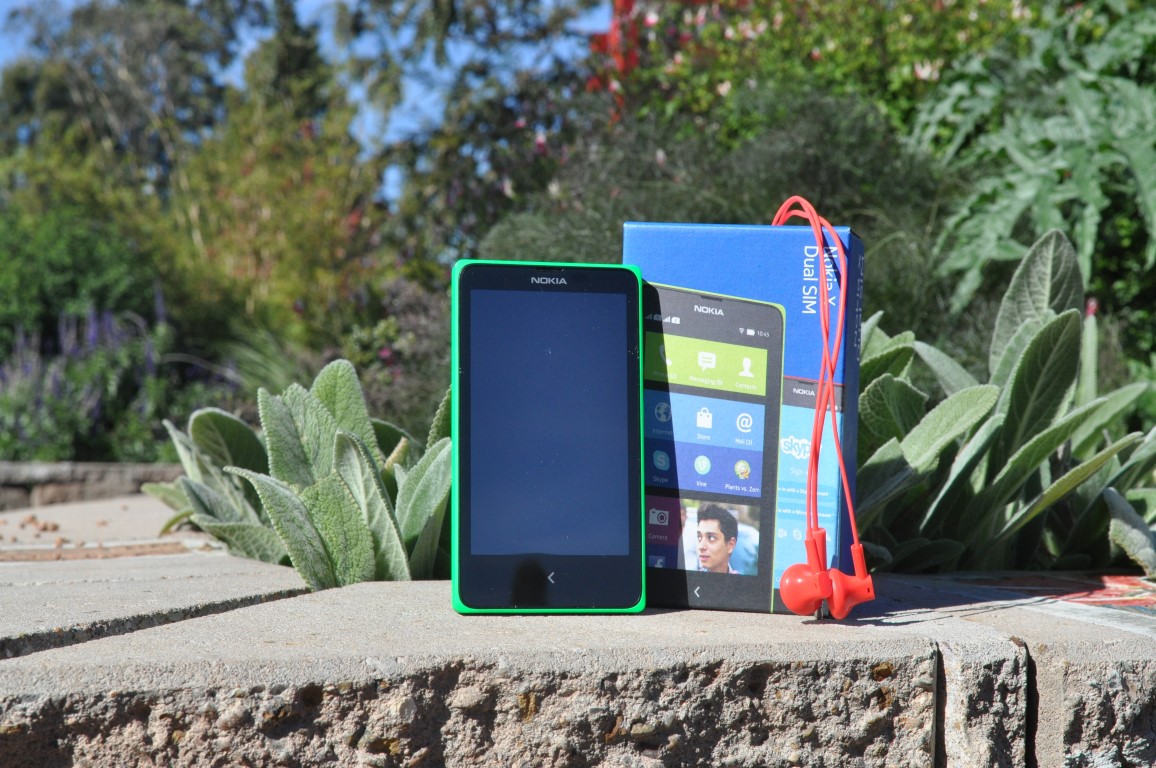
Nokia finally delivers a phone running Android – is it worthy of their name?
Ask just about anyone what their first phone was, the usual answer will be “some Nokia phone”. My history with mobile phones is littered with Nokia models, from the analogue Nokia 2100 to the 5110, 8210 and 3350. When Nokia failed to truly embrace the oncoming smartphone revolution, I was forced over to early ‘smartphone platforms’ running the likes of PalmOS and Windows Mobile, before finally I finally switched to Android. Like many Australians, Nokia holds a special place in my phone-loving heart.
When Stephen Elop, joined Nokia as CEO in 2010, there was trepidation as to where he would take the Finnish manufacturer. He quickly terminated Nokia’s replacement for Symbian (MeeGo), allowing the team to release just one phone – the Nokia N9. Many commentators and fans wanted to see Nokia go to Android and were disappointed when, in the now-infamous “burning platform” memo, he made it clear that he intended to put his former employer’s – Microsoft‘s – budding Windows Phone mobile operating system on Nokia phones, citing the dominance of OEMs like Samsung as a barrier to entry into the Android market.
Fast-forward to CES 2014 when, after months of rumours and speculation, Nokia finally announced the Nokia X series. Surprising commentators with not one but three phones with different screen sizes and specs, the phones would eschew Google’s services and rely on Nokia’s and Microsoft’s own. Nokia had effectively done for an Android phone what Amazon did for tablets with the Kindle Fire and divorced Android from the services with which it’s most commonly associated.
The Nokia X series phones are aimed at sales in ‘emerging markets’ – that basically means low-end hardware that can be made cheap and sold cheap in places like India, Asia and Latin America.
We’re reviewing one of the first phones to be released – the Nokia X. The phone is not officially available in Australia, with Nokia Australia still evaluating the phones for our market. However, Mobicity and Yatango are selling them, so if you want to purchase one, you can. Should you?
- It’s a Nokia phone, and it’s running Android!
- Dual-SIM
- FastLane is actually very useful
- Laggy, slow performance
- Nokia App Store severely lacking in apps
- Capacative button (one single button) is annoying
Hardware
The Nokia X’s hardware is not going to blow you away. It’s not top of the line, but before you write it off you need to remember the market the phone is made for.
The base model has a 1GHz dual core Qualcomm Snapdragon processor, paired with a miserly 512MB of RAM. Internal storage is almost non-existent, with around 1.2GB of available space for you to install apps and store media/photos. You can however use a microSD card to store more.
The front of the phone features a meagre 4-inch IPS LCD Display with an 800×480 resolution, below which you’ll find a single capacative “back” button. There’s no front-facing camera, but you do get a fixed-focus 3MP camera on the rear of the phone.
Bottom line: the hardware is basic, and you shouldn’t expect the earth from the Nokia X… because that’s what it delivers.
Design
Nokia’s has a long and proud history with phone design, and it’s well-deserved. They’ve often innovated in design and driven the phone industry forward as a whole. They own patents on mobile technology, and designed some of the most iconic phones ever released. Sadly, the Nokia X isn’t likely be considered an iconic design. Rather than using the company’s own, pleasant mid-to-high-end Lumia design language, the Nokia X seems more based on their Asha phones when it comes to design. It has a large bezels, sharp edges and is generally quite clunky.
So the design might not be great, but it is at least colourful. The Nokia X is available in Black, White, Red, Green, Yellow and (hold me back from purchasing another one) Cyan. I gravitated towards the Green variant, purely because Mobicity didn’t have the Cyan or Yellow available at the time of purchase. Your colour selection is ultimately a personal choice.
Notably, the Green Nokia X comes with a clashing set of red-coloured headphones – an odd choice that seemingly clashes with the bright green phone, but in the end it actually works.
Looks aren’t everything though, and when you’re holding the Nokia X you’re instantly aware that it’s a chunky piece of machinery. It’s a mere 2 grams lighter than a 5-inch Nexus 5, and a couple of millimetres thicker to boot. That thickness could actually be due to the shell that encompasses the phone.
The phone consists of a chasis which contains the electronics and a separate polycarbonate shell which you remove in order to access the battery, SIM card slots and the microSD card. The shell is pretty basic, with buttons built in to the side and cut-outs on the bottom and top for the microUSB port and 3.5mm headphone jack. You also get a a Nokia logo etched into the back near the hole that the camera pokes through. The back also makes the phone wider, adding to the already-wide frame. The Nokia X is bezelicious to start with, and ends up even wider due to the coloured shell.
It’s the combination of thick body and the plastic shell which sometimes makes the Nokia X uncomfortable to hold, especially when gripping it to use as a phone. The shell has sharp corners on the sides, but a very pleasing curved back that nestles comfortably in your hand — if you can forget those corners. It’s a love/hate relationship with the design of the Nokia X, and it’s not just gripping it.
Using the Nokia X means that you’ll have to get used to using the phone with the volume rocker and power button on the right hand side, with the power button sitting just under the volume rocker. It’s a configuration those of us with Samsung and LG phones might not be used to, though other OEMs like Sony, ZTE and Huawei have similar layouts. There’s no other buttons on the phone, however you get an earphone jack at the top and a microUSB port at the bottom.
As far as I’m concerned, the Nokia X is actually pretty to look at and semi-comfortable to hold, but its hard to look past those sharp edges. It’s not going to be remembered as one of the greats of the Nokia range, but it will be remembered if only for being an Android phone from a Windows Phone company.
Screen
The 4-inch IPS LCD Display on the Nokia X isn’t the highest resolution, but it’s also not the lowest we’ve seen. At 800×480 it’s considered fairly low-end by today’s standards, yet only three years ago that was the standard. At 233.24 PPI, the screen won’t qualify for ‘retina’ status, and doesn’t even hit half the rumoured pixel density of the upcoming LG G3 (534.04), but it does the job. You have to remember the market this phone is aimed at.
While it might not have the resolution or pixel density you want, it certainly brings the brightness. If you turn the screen on at night, it’ll light up a room. During the day, it’s perfectly legible outside, though perhaps a touch too bright when you’re inside. The screen does have a little light bleed around the bottom of the screen – something you do see on low-end smartphones – but it’s not something that’s a worry in day to day use.
The major downside is the latency when registering touch response. This could be due either to the screen or the low-end specs, but the phone seems to takes an age to respond to touch input. Regardless of the cause, be prepared to wait a while when using the Nokia X.
The glass atop the screen does seem to attract marks, dirt and fingerprints quite willingly, but remember – it’s glass, simply wipe it off and it’s good to go.
Battery life
Battery life is always somewhat subjective. The Nokia X comes with a 1,500 mAh battery, and it’s removable so you have the option of grabbing and carrying another battery if needed.
For the purposes of the review, I had it running as a WiFi hotspot to supply data to my Nexus 5 purely to receive Hangouts messages (a service missing from the Nokia X, we’ll get into this later), it was also syncing my two Gmail accounts and Twitter, as well as web surfing, but I still managed to get almost a full day of use out of it.
The phone takes a standard microUSB charger. As an import model, my unit didn’t come with an Australian plug, but MobiCity supplied it with an international adapter (thanks guys).
Camera
You’re not getting a Pureview camera here, it’s as basic as basic can be. The Nokia X has a 3MP fixed-focus sensor built into the back of the phone. There’s no flash and there’s no optical image stabilisation, so if you’re in low-light you may as well forget it.
Shots are acceptable in good light, however there’s a bluish tinge to the shots taken outside – maybe just my camera? Overall, they’re okay — I guess — for a 3MP sensor, but don’t expect much from the hardware.
The software for the Nokia X camera on the other hand, is surprisingly good. Whether it’s a sign of better camera hardware to come in future models (the Nokia XL has a 5MP camera) or just Nokia’s own attention to detail, the camera software has quite a few options from ISO level though noise reduction to white balance, sharpness, contrast and more. These options are surprisingly easy to access and alter within the app. There’s some things here that Google should really take note of.
Connectivity
You’ll be able to connect to WiFi, Bluetooth and 3G networks on the Nokia X, but that’s about it. It’s questionable whether ‘emerging markets’ need much by way of connectivity, but the basics are there. It’s decent and it works.
Calling on the Nokia X won’t get you HD Voice calls, but the handset delivers clear and decent sound on calls. Likewise, the Wi-Fi 802.11 b/g/n connection will have you connected to your wireless router with no issues.
Bluetooth is a little lacking, but that’s understandable given the target market. The Nokia X comes with Bluetooth 3.0 – it’s good enough to maintain a connection to your wireless headphones, but that’s about it. Your health trackers aren’t going to like it because most of them require Bluetooth 4.0 (BLE).
GPS works. In fact, it works quite well when you use it with Nokia’s Here Maps navigation service. What it doesn’t work well with is fitness tracking software, because there are literally no running/cycling mapping apps available in the Nokia App Store (again, we’ll get to this later).
There’s absolutely no video-out on the Nokia X. No Miracast, no Slimport, no MHL, nothing. This is not too big a deal though – a lot of people never use this function – but it’s worth a mention.
Sound
There’s a small speaker built into the rear and an earphone jack on the top of the phone. The Nokia X definitely won’t deliver BoomSound quality, or even anywhere close, but it’s loud – I’ll give it that. If you’ve ever missed a call because you couldn’t hear your phone, you’ll have no such excuse with the Nokia X.
Volume aside, the phone isn’t going to blow you away with its clarity, so listening to ‘Everything is Awesome’ (because you know you all purchased it on the way out of the cinema) is a pretty disappointing experience.
Performance
It’s bad. It’s really, really bad.
The Nokia X is laggy. It takes an age to respond to touch input and even longer to load apps. You’ll often double-touch an app or re-swipe something or even hit the back button again because nothing is happening on the phone.
The phone’s working at a disadvantage though. As a budget phone, Nokia hasn’t thrown great hardware into it. You get a 1GHz dual core Cortex-A5 Snapdragon S4 Play MSM8225 processor, Adreno 203 GPU and 512MB RAM, so it’s really not starting off on the best foot.
I’d run benchmarks on the phone… if there were any to run. There’s nothing in the Nokia App store, so, it’s off to extract APKs and sideload. AnTuTu is quite unforgiving with the Nokia X, giving it a score of only 7532. While the Nokia X scores higher than 50% of other devices on battery, it manages only poor on game performance, with a recommendation that only 2D games will run on it.
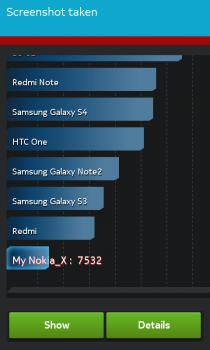 |
 |
Software
Android OS
The Nokia X is based on the AOSP version of Android – version 4.1.2 to be exact. What Nokia has done is uncouple all of Google’s services from Android and replaced them their own services. This means that there’s no CTS certification – or in laymans terms, no Google Play Store. Instead you get the Nokia App Store.
In theory, using Android 4.1.2 should actually be a great basis for updating the phone to higher Android versions in future – like perhaps Android 4.4, which is designed for devices running 512MB RAM – but in practice, especially with their sale to Microsoft complete, it seems unlikely this will ever occur. We wait in keen anticipation to see what will happen.
The lack of updates is a bit of an issue at the moment for me anyway. It’s an edge case – and the majority of users will never encounter this – but it’s worth mentioning. While reviewing the phone I paired it with my Pebble, extracted the Pebble APK from my Nexus 5 and sideloaded it onto the Nokia X (this was actually recommended by Myriam from Pebble). I installed an additional app from the Nokia App Store – Pebble Notifier – to handle some notifications from other apps, and this is where I encountered issues.
There was a notification to update Pebble Notifier from the Nokia X store, but when I tried to update it, it said I need to update my phone first. I checked in the settings for an update to the Nokia X, but nope – “Your system is up to date”. Essentially, I keep getting a notification from the app telling me I need to update, but I can’t update it.
Skins
Nokia has departed from the standard Android launcher that Google uses and most OEMs at least try to emulate. They’ve completely reworked the launcher, delivering a UI that seems to be stylistically more in-line with Windows Phone with tiles forming the home screen. The home screen also acts as your App Drawer. Nokia has introduced an activity stream called ‘Fastlane’ to track your activity on the phone.
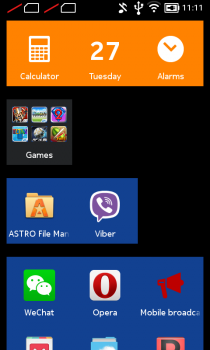 |
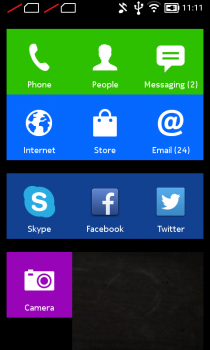 |
The live tiles are interesting and useful in their own way – similar to a widget – but with only a basic amount of glanceable information. The SMS and Email apps have a number below them to show how many unread messages you have, and the gallery tile shows up pictures in your gallery. It’s an interesting way to approach the UI, and quite useful in its own way as a replacement for widgets.
As your app drawer, the home screen can also be fairly easily organised. Like most OEM or third party launchers, you can create folders of apps which you can name, categorise and move around the home screen like a tile.
Fastlane
A swipe to the left from the home screen reveals Fastlane. This is something new that Nokia have introduced, and in itself it’s perhaps one of the most attractive parts of the Nokia UI. It’s is simply a list of activities on your phone in chronological order, capturing everything you’ve done.
Fastlane takes the place of your notification shade, although you do still have an actual swipe-down ‘notification shade’ but that now just shows quick toggles. Instead, to see missed calls and messages you go to Fastlane.
It’s not just calls and SMS’s though – Fastlane also shows your recent activity on the phone. Take a photo and it shows up. Make, receive or miss a call and it’s there. Turn your wireless hotspot on – there it is.
 |
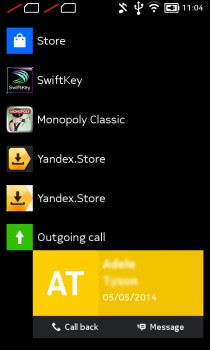 |
The utility of Fastlane is perhaps the only thing I’ll miss in going back to a more traditional Android launcher. It’s a really intriguing piece of UI, and something I’d love to see in other launchers.
I’d also like to address the single capacitive button that exists on the phone. It’s essentially a combination back/home button. Hit the button once and you’ll find it acts as a back button for the most part. Hold the button down and it will take you back to your ‘Home’ screen.It’s a messy way to do it, but it does work – I guess.
The launcher itself is interesting and on Android we always like to see new things tried. But hey, this is Android. Side-load Nova, Apex, Action launcher or whichever launcher you prefer and you’ll have your standard home screen in no time.
Bundled Apps
Nokia had a fair bit of work to do in removing all of Google’s services. Not only did they have to replace internal systems such as location services, but they also had to replace a whole range of app functionality like mapping, web browser, email client and more. This is where Nokia’s suite of bundled apps comes in.
When you first sign in you get a list of basic apps: Phone, People, Messaging (SMS), Internet (Web Browser), Store (Nokia App Store), Email, Camera, Mix Radio, Music, FM Radio (Yes, the Nokia X has a built-in FM Radio), Here Maps, Calculator, Calendar, and Alarm clock. Most of these are just the AOSP versions sitting on Nokia’s platform.
The Nokia-specific apps are actually fairly decent. Here maps app works like a charm – it’s a very good service that should keep Google innovating for years to come. Nokia Mix Radio is a pretty cool service, but I almost never listen to music so it’s wasted on me.
Email works okay. I could sync my GMail, Google Apps email and eventually an Outlook account, but it’s not a great experience. In fact, it’s incredibly frustrating – but it does work. The same can be said of all the apps included although the Alarm Clock app is quite good.
Nokia has also included a range of larger name apps installed by default: Skype, Facebook, Viber, Opera, WeChat and Astro File Manager. In what appears to be a partnership, they’ve also included a range of games from Gameloft and EA Sports like Tetris, Game of Life, Wonder Zoo and Danger Dash. These inclusions obviously show that they have approached at least a couple of big names to get some entries into their own app ecosystem, but with precious little space to start with on the phone, you really have to question whether they should be there.
Nokia has also included a soft keyboard on the Nokia X which you’ll actually find quite decent to use. There’s good-enough word suggestions, and swipe gestures similar to Swiftkey’s Flow which make the keyboard a valid option – just remember though, Swiftkey is in the Nokia App store if you need it.
Microsoft
What’s glaring on Nokia X isn’t what’s included but rather what’s not. Integration with Microsoft services is notably missing, despite Microsoft’s purchase of Nokia. Where you would expect there to be range of Microsoft apps and a push to use Microsoft services, there’s nothing. No Office, no OneDrive, no Hotmail/Outlook app, nothing.
Trying to load your Outlook mail into the email app is a trying experience itself, while a Gmail account hooked in effortlessly. This is not to say that using Gmail on the Nokia X is a pleasing experience, but it works.
With such a Windows-Phone-like interface and their new overlordsowners, it’s confusing that there isn’t more integration of Microsoft’s apps and services. One simply has to look at the amount of options Microsoft offers Android users, in Google Play and you’ll be left wondering why none of those apps have been pre-installed.
It’s not just that they’re not pre-installed, but they’re also hard to find in the Nokia App Store. Searching for Microsoft Apps, you’ll see different entries under different manufacturers. Their Outlook app is under Outlook.com. It’s a bit of a mess, but then quite frankly so is the Nokia App Store.
Edit: Ok, as of update 1.1.2.2 Nokia has now included Microsoft OneDrive on the Nokia X. It’s still quite amazing that this phone was ever released so bereft of Microsoft integration.
Nokia App Store
Nokia has attempted to completely detach the Android OS from Google, which means saying goodbye to Google’s own Play Store as Amazon did with their Kindle hardware and their Amazon App store. While Amazon spent years building up a catalogue of apps, games and media (if you’re in the US), Nokia seems to have jumped in and announced open slather for the Nokia App store, and it shows.
The Nokia App store is akin to the wild west, or perhaps the early days of the Android Market. Seemingly uncurated, it’s full of many very basic applications with wildly varying degrees of usefulness. By forgoing Google certification and hence not receiving access to Google Play, Nokia has missed out on a vast majority of apps. There are some ‘big’ apps available such as Vine, Twitter, Facebook, Swiftkey, Pocket (Read It Later) and Lastpass (a timely entry at the moment), but there’s a much larger list of apps which are NOT available.
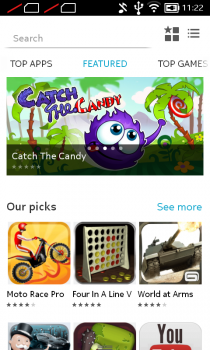 |
 |
 |
The list of Apps not available in the Nokia App store is obviously headlined by the Google suite of apps – YouTube, Drive, Hangouts, Calendar and the full suite of Play services, but the list doesn’t stop there. Instagram, Evernote, IMDB, Feedly, Dropbox, and PayPal are nowhere to be found. There’s whole categories of apps that just aren’t available, like good Reddit apps (BaconReader, redditisfun), run tracking Apps (Runkeeper, Strava, Nike+, Map My Run) and there are no podcatching apps (Pocketcasts, BeyondPod, Dogcatcher).
Likewise with the big name apps, with the phone not actually selling in Australia, there’s no local Catchup TV apps (iView, SBS On Demand, Plus7 or TenPlay). Also missing are banking apps from Commonwealth Bank, NAB, Westpac, St George, and ING. I’m in two minds about the banking apps though, because while not technically an ‘untrusted’ source the Nokia X is currently unproven when it comes to app security. Convenience-wise, it’s still a miss.
If you’re missing apps from the store, Nokia themselves have recommended side-loading apps as an alternate method of getting apps. While they haven’t gone as far as recommending you use one of the APK Extractor apps available on Google Play or one of the web services which pull them from Google Play, they’re still advocating a practice which we advise you to be careful using.
There’s a problem you’ll hit straight away with side-loading apps because some are encrypted and won’t extract or come down from the web in any sort of usable form. Basically, if a developer doesn’t want you using their App outside of Google Play and has encrypted it (as is their right to do), you can’t side-load it.
Even if you do manage to side-load an App, you’re not going get automatic updates for it, and you’ll be forced to repeat the process of downloading and side-loading it again just to get those updates. With security such a big concern these days, you want those updates as soon as possible.
You’ll also find some apps are intrinsically dependent on Google Play Services. Google has done a fantastic job in the last couple of years in selling developers on their services (like cloud notifications) and so apps hook into APIs that are just missing on Nokia’s platform. Some apps will just refuse to load, despite side-loading successfully.
Third Party App stores
Nokia hasn’t just relied on the Nokia App Store or side-loading though – there’s also integration with the Yandex Store, a third party store which has over 100,000 apps in their database. Search for an App like Box in the Nokia App store and you’re advised that though it doesn’t appear in the Nokia App Store it is available in Yandex.
This isn’t a smooth experience, even if you do find the app in there. If you haven’t installed the Yandex store, you’re prompted to install it. Once installed you can select Yandex, you’re prompted to open it, but you won’t be taken directly to the App, you’re searching for – in fact, if you’re new to Yandex you’ll have to go through the rigmorale of signing up to their service just to find the app you were looking for in the Nokia App Store — what was it, again?
It’s just an added layer of complexity in trying to install apps. It’s understandable that Nokia wanted to be completely free of Google, especially with their new owners coming along. Nokia Australia did respond to a late night rant on Twitter about the lack of Apps in the Nokia App Store, saying they are looking to add more apps all the time. Well, of course they are – and they’re treading on some toes to do it.
Alternatively, you can install the Amazon App Store – again, by side-loading the APK – or the SlideMe market. You can access any number of third-party Android app stores that are out there. But in the end, as a user, you just constantly question why Nokia didn’t just suck it up get the phone certified by Google to run Google Play.
Hack The X
Thankfully, there are options with the Nokia X. There’s a few developers hard at work over at XDA-Developers who have been releasing software for the phone such as a stock AOSP ROM which allows Google Play Services and means you can have all your Google Apps installed quite quickly and painlessly.
I have heard that there are downsides to having stock Android on the Nokia X, and I fully intend to put one of these ROMs on and play with stock Android on the phone when I have some spare time.
Nokia X
- 4.0-inch IPS LCD at 480×800 resolution
- Dual-core 1GHz Qualcomm MSM8225 Snapdragon S4 Play pro with Adreno 203 GPU
- 512MB RAM
- 4GB storage (1.2GB available to the user) with microSD card slot (up to 32GB)
- 3MP fixed-focus camera
- Wi-Fi 802.11 b/g/n, Bluetooth 3.0, GPS with A-GPS, FM Radio
- Bright Green, Bright Red, Cyan, Yellow, Black, White
- Radios:
- 2G: GSM 850/900/1800/1900(SIM1 and SIM2)
- 3G HSDPA: 900/2100
- Android 4.1.2 with Nokia UI
- 1500 mAh Li-Ion battery
- 115.5x63x10.4mm @ 128grams
For me, the Nokia X was a must-buy as soon as it was launched, but not for any functional standpoint. It was more curiosity than anything else. I wanted to see how an Android phone devoid of all Google services ran. It turns out, the overall answer is “okay”, but I wouldn’t want to live with it.
The hardware is slow. The software is far more interesting, but it’s limited by the barren app ecosystem and lack of Google Play Services. Despite assurances from Nokia that they will improve the ecosystem, it’s not looking good long-term. Developers I spoke to essentially aren’t sold on the extra work involved in decoupling their apps from Google Play Services. Personally, I’m far too invested in Google’s services to make a go of using the Nokia X as a “daily driver”. The lack of Hangouts and a good Gmail app, and essentially a lot of high-profile apps, is too much of a deal-breaker.
From the standpoint of a phone aimed at developing markets though, the Nokia X has its merits. As a starter phone, it could certainly introduce a range of people into Nokia’s ecosystem of apps like Mix Radio or Here Maps, but it would be a far better proposition for those people wanting these services to look at a low-end Lumia phone.
The Nokia X will retain a place in my phone collection, but I can’t say I’ll ever use it as my main phone unless things take a dire turn for the worst. Nor will I be able to recommend it to anyone who asks. It’s a decent first attempt by Nokia, but if you’re after a phone in the budget range, Motorola’s Moto G (while slightly more expensive) or even the Moto E is likely to deliver a far better experience.

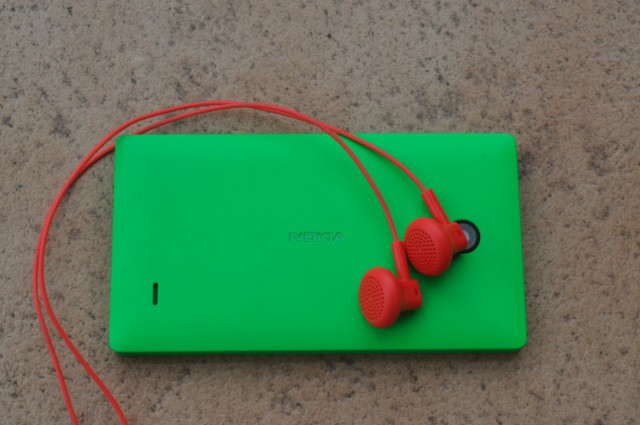








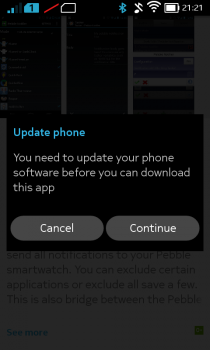



regarding why they didn’t suck it up and get Google-certified — would this mean they can’t plug their own services (particularly maps?) While most of their services these days seem tacked on, maps specifically is one of the the last things that Nokia would want to give up; they’ve poured a heck of a lot of money into them.
I am also interested if Nokia (the still-independant Finnish company) will continue down this line once Nokia’s phone division (the bit that got sold to Microsoft) gets rebranded as Microsoft Mobile and Nokia proper is allowed to build phones again.
In terms of budget device running stock firmware, I’d definitely say the Moto E is the better option.
Typos found.
Either in the Performance section or in the Specs section. Performance – Adreno 203. Specs – Adreno 320.
Nokia App Store – bnking
Would probably agree, Moto E is a nice budget handset. Typos fixed.
I think there’s something missing from the Cons list for the device: 3G bands – Optus/old Vodafone 900/2100
You can add that to your cons list, when you start your website. Till then Daniel is the reviewer just leave him alone, thank him for the review and stop commenting.
Not really a con — the Nokia X is pitched as a fairly global low cost handset, and in terms of worldwide use, UMTS 900/2100 are the most common frequencies outside North America (where this phone probably isn’t aimed anyway)
Thanks Chris. I didn’t realise that 900/2100 was the primary 3G bands in the main target markets for the Nokia X.
🙂
My first phone wasn’t a Nokia. It was a Motorola MicroTAC International 7200.
It wasn’t until my fourth mobile phone that I had a Nokia, the Nokia 5510.
🙂